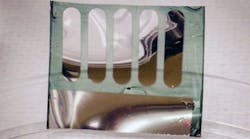Solar power may be green, but solar cells typically are fabricated on glass or plastic, which isn’t easily recyclable. Their petroleum-based substrates aren’t eco-friendly either. But the Georgia Institute of Technology and Purdue University have jointly developed efficient solar cells using cellulose nanocrystal (CNC) substrates derived from trees and other plants, which means they can be recycled in water quickly at the end of their lifecycle (see the figure).
Related Articles
• Organic Solar-Cell Architecture Taps Next Performance Plateau
• Organic Solar Cells Start To Take Off - Big Time!
• As PV Technology Nears Grid Parity, What Does Solar Technology Promise?
These organic solar cells reach 2.7% power conversion efficiency, which the researchers aim to improve by optimizing the optical properties of their electrodes. The CNC substrates are optically transparent, so light can pass through them before a very thin layer of an organic semiconductor absorbs it. During the recycling process, the solar cells are immersed in water at room temperature. The CNC substrate dissolves in minutes, and the solar cell can be separated into its major components.
“Our next steps will be to work toward improving the power conversion efficiency over 10%, levels similar to solar cells fabricated on glass or petroleum-based substrates,” said Bernard Kippelen, Georgia Tech College of Engineering professor and director of the Center for Organic Photonics and Electronics. “We will also coat these cells with an eco-friendly, thin environmental barrier coating to protect the cells from water and oxygen when operating in the field.”
Paper substrates are better for the environment, researchers say, but they have shown limited performance because of their high surface roughness or porosity. The cellulose nanomaterial substrates, though, have a low surface roughness of only about 2 nm. The researchers also note that the nation’s forest product industry could produce tens of millions of tons of cellulose nanomaterials once large-scale production begins, potentially in the next five years.
Georgia Tech Center for Organic Photonics and Electronics
Purdue University
